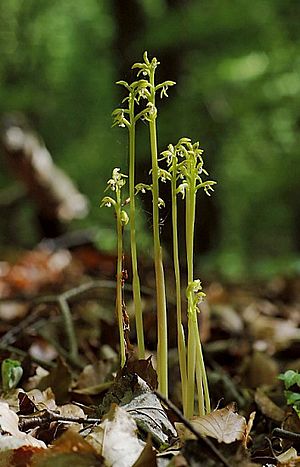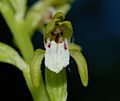Early coralroot facts for kids
Quick facts for kids Early coralroot |
|
|---|---|
 |
|
| Scientific classification | |
| Genus: |
Corallorhiza
|
| Species: |
trifida
|
The Early Coralroot (scientific name: Corallorhiza trifida) is a special type of coralroot orchid. People also call it the Northern Coralroot or Yellow Coralroot. This plant grows naturally across North America and Eurasia. You can find it in many places around the northern parts of the world. This includes countries like the United States, Canada, Russia, China, and most of Europe. It even grows in Greenland and parts of India and Pakistan.
About the Early Coralroot
What Does It Look Like?
The Early Coralroot plant is usually yellowish-green. It doesn't have any leaves, which is quite unusual for a plant!
How It Gets Food
Most plants make their own food using sunlight. This process is called photosynthesis. The Early Coralroot is different. It gets some of its food from tiny fungi that live in the soil. This is like borrowing food from a friend!
This special way of getting food is called myco-heterotrophy. It means the plant partly relies on fungi for nutrients. The fungi it connects with are usually from a group called Tomentella.
But the Early Coralroot isn't completely dependent on fungi. It also has chlorophyll, which is the green stuff in plants that helps them make food from sunlight. So, it can make some of its own food too. This means it's a bit of a mix: it gets some food from fungi and makes some itself.
See also
 In Spanish: Raíz de coral para niños
In Spanish: Raíz de coral para niños



